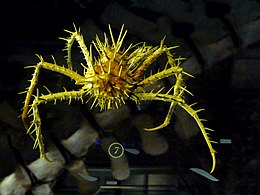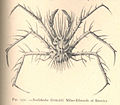Neolithodes grimaldii
| Neolithodes grimaldii | ||||||||||||||||||||||||||||
|---|---|---|---|---|---|---|---|---|---|---|---|---|---|---|---|---|---|---|---|---|---|---|---|---|---|---|---|---|
 Múzeumi példány
| ||||||||||||||||||||||||||||
| Rendszertani besorolás | ||||||||||||||||||||||||||||
| ||||||||||||||||||||||||||||
| Tudományos név | ||||||||||||||||||||||||||||
| Neolithodes grimaldii (A. Milne-Edwards & Bouvier, 1894) | ||||||||||||||||||||||||||||
| Szinonimák | ||||||||||||||||||||||||||||
| ||||||||||||||||||||||||||||
| Hivatkozások | ||||||||||||||||||||||||||||
A Wikifajok tartalmaz Neolithodes grimaldii témájú rendszertani információt. A Wikimédia Commons tartalmaz Neolithodes grimaldii témájú kategóriát. |
A Neolithodes grimaldii a felsőbbrendű rákok (Malacostraca) osztályának tízlábú rákok (Decapoda) rendjébe, ezen belül a Lithodidae családjába tartozó faj.
Nemének a típusfaja.
Előfordulása
[szerkesztés]A Neolithodes grimaldii előfordulási területe az Észak-Atlanti-óceán. Nyugaton Grönlandtól egészen az Amerikai Egyesült Államokbeli Észak-Karolináig található meg, azonban nem hatol be a Szent Lőrinc- és a Fundy-öblökbe. Keleten a Brit-szigetektől egészen Mauritániáig.
Megjelenése
[szerkesztés]Ennek a rákfajnak a páncélmérete 11-17 centiméter között van, lábfesztávolsága a legnagyobb példányok esetében 120 centiméter; a tömege elérheti 2,28 kilogrammot is. Színezete példánytól függően a vöröstől a rózsaszínig, vagy az okkersárgáig változik. Az erős páncélján, lábain és ollóin számos nagy méretű tüske látható. A végtagjai a testéhez képest hosszúak és vékonyak.
Életmódja
[szerkesztés]Mélytengeri rák, amely 900 méteres mélységben tartózkodik. A lárva állati planktonnal táplálkozik; a felnőtt szerves törmeléket és dögöket fogyaszt.
Képek
[szerkesztés]-
Rajzok a
-
rákról
Források
[szerkesztés]- Neolithodes grimaldii (A. Milne-Edwards & Bouvier, 1894) WoRMS
- Intergovernmental Oceanographic Commission (IOC) of UNESCO. The Ocean Biogeographic Information System (OBIS), available online at http://www.iobis.org/
- Türkay, M. (2001). Decapoda, in: Costello, M.J. et al. (Ed.) (2001). European register of marine species: a check-list of the marine species in Europe and a bibliography of guides to their identification. Collection Patrimoines Naturels, 50: pp. 284-292
- Newfoundland and Labrador Department of Fisheries and Aquaculture. 2003. Porcupine Crab Exploratory Fishing, June to November, 2000. , available online at http://www.gov.nf.ca/fishaq/FDP/projectreports/fdp_151.pdf
- Pohle, G.W. (1990). A guide to decapod Crustacea from the Canadian Atlantic: Anomura and Brachyura. Canadian Technical Report of Fisheries and Aquatic Science. 1771. 29 p.
- Squires, W.A. 1976. The birds of New Brunswick. Second Edition. The New Brunswick Museum. Saint John. 221 p.
- Felder, D. L., Álvarez. F.,Goy, J.W. & Lemaitre, R. (2009). Decapoda (Crustacea) of the Gulf of Mexico, with comments on the Amphionidacea,. Felder, D.L., and Camp, D.K. (eds), Gulf of Mexico - Origins, Waters, and Biota. Vol. 1. Biodiversity. Pp. 1019–1104 (Texas A&M University Press: College Station, Texas)., available online at https://web.archive.org/web/20190726044217/http://biogomx.net/sites/default/files/pdfs/chapters/59-Felder%20et%20al%202009-Decapoda%20of%20the%20GoMx.pdf
- Mclaughlin, P. A.; Komai, T.; Lemaitre, R.; Listyo, R. (2010). Annotated checklist of anomuran decapod crustaceans of the world (exclusive of the Kiwaoidea and families Chirostylidae and Galatheidae of the Galatheoidea. Part I – Lithodoidea, Lomisoidea and Paguroidea. The Raffles Bulletin of Zoology. Supplement No 23, 5-107.
- Hayward, P.J.; Ryland, J.S. (Ed.). (1990). The marine fauna of the British Isles and North-West Europe: 1. Introduction and protozoans to arthropods. Clarendon Press: Oxford, UK. ISBN 0-19-857356-1. 627 pp.




